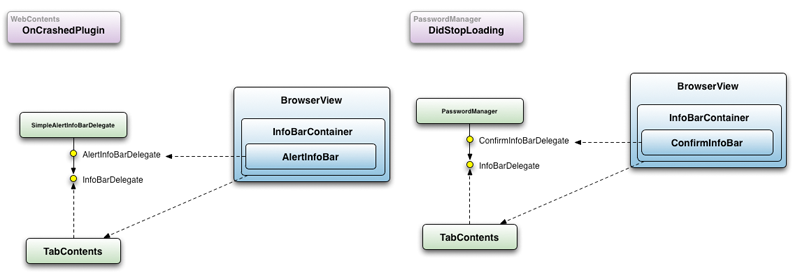Info Bars
Info Bars are informational messages associated with a Tab. They are displayed when something happens in the Tab that the user should be aware of, e.g. a plugin has crashed, or the user can save a password they just entered. They are designed to be non-modal so as not to interrupt the workflow.
Proposed Design
The TabContents object provides a simple API that clients can use to add InfoBars to the presentation of that Tab. A client must have an object implementing an InfoBarDelegate interface which provides some basic information and callbacks for an InfoBar UI. It calls TabContents::AddInfoBar to add the InfoBar to that Tab. The TabContents uses the NOTIFY_TAB_CONTENTS_INFOBAR_ADDED notification (source = TabContents, details = the delegate) to broadcast the change to the UI. There is also a symmetrical NOTIFY_TAB_CONTENTS_INFOBAR_REMOVED.
On the UI side, Info Bars are hosted and owned by the window UI, more specifically by a views::View subclass called InfoBarContainer that is hosted within the BrowserView class.
There are several different types of InfoBar, and corresponding InfoBarDelegate interfaces that provide common InfoBar appearance. The simplest is AlertInfoBar and AlertInfoBarDelegate, which allows for the display of a string message and optional icon. If the client does not want to implement this message it can create an instance of SimpleAlertInfoBarDelegate, which is constructed with a string and an icon, and deletes itself automatically when the InfoBar is closed.
Another common type is ConfirmInfoBar and ConfirmInfoBarDelegate, which allows the client to ask the user a question and control buttons to receive their response. The delegate interface notifies the client of the button chosen.
It is possible for the client to create custom InfoBars by subclassing the InfoBar view and the InfoBarDelegate interface. InfoBarDelegate should be platform independent, as it is used by TabContents which is platform independent. The implementation of an InfoBar may vary significantly from platform to platform.
Here is a diagram showing the relationship between the objects in a couple of use cases:
Add Flows
An instance of object X "x1" implements AlertInfoBarDelegate, and its lifetime is managed by some other object. Here is the flow for its addition to TabContents t:
t->AddInfoBar(x1);
This adds x1 to t's list of InfoBarDelegates, and broadcasts a NOTIFY_TAB_CONTENTS_INFOBAR_ADDED that the InfoBarContainer in the associated hosting BrowserView observes. InfoBarContainer calls x1's CreateInfoBar method to construct a platform-specific View for the InfoBar and adds it to its list of children, beginning an animation that causes the InfoBar to appear to slide in.
Remove Flows
The user clicks the close button on x1's InfoBar view. The InfoBar view communicates, via its InfoBarContainer back through to the selected TabContents telling it to remove the associated InfoBarDelegate. The TabContents removes the delegate from its list and broadcasts NOTIFY_TAB_CONTENTS_INFOBAR_REMOVED. The InfoBarContainer observes this message and begins an animation that causes the associated InfoBar to appear to slide out. When the slide out animation is completed, the InfoBar calls through to its delegate saying that the InfoBar is about to be deleted. The InfoBarDelegate implementation can use this as an opportunity to delete itself if it is not managed some other way.
Tab Switch Flows
When the user switches tabs, the BrowserView receives a TabSelectedAt function call via its implementation of TabStripModelObserver. The BrowserView calls the ChangeTabContents method on the InfoBarContainer, which causes it to reset its selected TabContents value, and remove and add observers from the old and new TabContents. It also uses this opportunity to update its visual state, removing the child views associated with the old TabContents and constructing a new set of InfoBar views for the newly selected TabContents. InfoBar views are designed to be destroyed and re-created every time tab selection changes. When InfoBar views are created in this mode, there is no animation as they are added and removed.
Another important note: The InfoBarContainer's active TabContents is set to NULL whenever a TabContents is detached from a window, much as the BrowserView's TabContentsContainer's active TabContents is set to NULL. This is done because when you drag the last tab out of a window, that window is destroyed, which results in WM_NCDESTROY being sent to the frame and the focus manager to be shut down. However the view hierarchy is not destroyed until OnFinalMessage. Because both InfoBarContainer and TabContentsContainerView configure the focus manager, this shutdown behavior means that both of these views may try and configure the FocusManager after it has been destroyed.
A possible improvement to this situation would be to have the RootView delete its view hierarchy when the window is destroyed, rather than waiting for OnFinalMessage.
InfoBar Uniqueness
The InfoBarContainer supports showing of multiple child InfoBar at the same time. This allows client code to queue up multiple notices that the user can respond to at their leisure. Sometimes however client code may wish there to be only one InfoBar for a specific type of notice. The InfoBarDelegate has an Equals method that can be implemented to support this functionality. Consider the AlertInfoBarDelegate, which is used to display a simple text string. The TabContents will never allow two AlertInfoBarDelegates with the same text string to be shown. AlertInfoBarDelegate overrides InfoBarDelegate::EqualsDelegate to test equality by comparing text strings with another AlertInfoBarDelegate. This ensures that multiple InfoBars with the same string are not added.
InfoBar Layout
The InfoBarContainer overrides views::View::GetPreferredSize to communicate to the BrowserView its total size during Layout. When InfoBars are added or removed, or their height changes due to animations, the InfoBarContainer tells the BrowserView to update its Layout.
InfoBar Expiration
By default, InfoBars "expire" (automatically close) after a reload or a navigation to the TabContents that they were opened within. Delegates can override the ShouldExpire method to customize this behavior.
InfoBar View Ownership
InfoBar views are not owned by the view hierarchy. They automatically delete themselves after they are removed from the View hierarchy. This is not done immediately but after a return to the message loop since the stack of View hierarchy changed notifications must be allowed to completely unwind.
